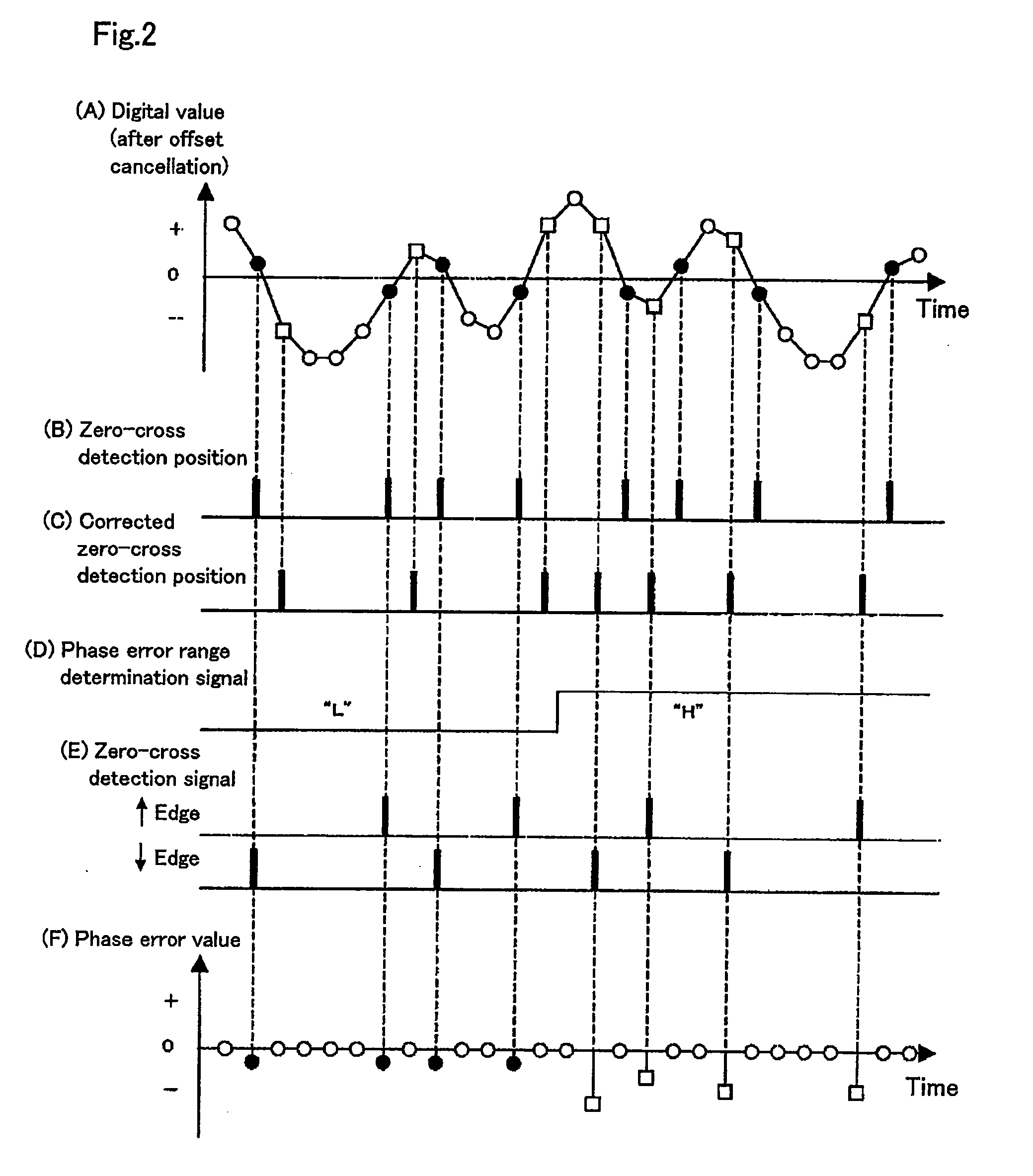Clock Signal Generation Device, Semiconductor Integrated Circuit, and Data Reproduction Method
a clock signal and clock signal technology, applied in the field of clock signal generation devices, semiconductor integrated circuits, and data reproduction methods, can solve the problems of reducing the time required for clock signal reproduction, affecting the quality of clock signal reproduction, and reducing the frequency error between the reproduced signal and the clock signal, so as to increase the capture range, stable clock signal, and the effect of reducing the time required
- Summary
- Abstract
- Description
- Claims
- Application Information
AI Technical Summary
Benefits of technology
Problems solved by technology
Method used
Image
Examples
first embodiment
[0077]FIG. 1 is a block diagram showing a configuration of a PLL circuit in a first embodiment of the present invention.
[0078]An optical head 102 irradiates an optical disc 101 with a light beam, detects an amount of the reflected light from the optical disc 101 and outputs an electric signal. An analog signal processing circuit 200 extracts a reproduced signal from the electric signal output from the optical head 102. The analog signal processing circuit 200 includes a preamplifier 201 for amplifying the electric signal, a gain control circuit (AGC) 202 for controlling the amplitude of the amplified signal to be constant and an equalizer 203 improving a frequency characteristic.
[0079]Next, a configuration of a PLL circuit 300 will be described.
[0080]The PLL circuit 300 generates a clock signal which is synchronous with a reproduced signal. The clock signal generation circuit 300 includes: an A / D converter 301 for digitalizing the reproduced signal with the clock signal; an offset c...
second embodiment
[0118]FIG. 9 is a block diagram showing a configuration of a clock signal generation circuit in a second embodiment of the present invention.
[0119]The clock signal generation device shown in FIG. 9 generates a clock signal using an optical disc 1101 on which information is recorded. The clock signal generation device includes: an optical head 1102; an analog signal processing circuit 1200; and a clock signal generation circuit 1300.
[0120]The optical head 1102 irradiates the optical disc 1101 with a light beam 1102a, detects an amount of the reflected light from the optical disc 1101 and generates an electric signal 1102b based on the amount of the reflected light.
[0121]The analog signal processing circuit 1200 extracts a reproduced signal 1200a from the electric signal 1102b. The analog signal processing circuit 1200 includes: a preamplifier 1201 for amplifying the electric signal 1102b; a gain control circuit (AGC) 1202 for controlling the amplitude of the amplified signal to be co...
third embodiment
[0161]FIG. 16 is a block diagram showing a configuration of the clock signal generation circuit in a third embodiment of the present invention. In FIG. 16, the same reference numerals are given to the elements which are the same as those shown in FIG. 9, and the descriptions of those elements will be omitted.
[0162]The offset canceller 1302 is controlled such that a center level of the digital value 1301a output from the A / D converter 1301 becomes zero. The offset canceller 1302 includes: a zero level detector 3021; binary DUTY detector 3022; an accumulator 3023, a subtracter 3025; and a higher frequency band emphasizing filter 3024.
[0163]The higher frequency band emphasizing filter 3024 outputs a higher frequency band emphasizing filter output value 3024a which is obtained by emphasizing a higher frequency band component of the digital value 1302a after the offset cancellation. For example, a short mark, such as 2T or 3T where the amplitude can be easily reduced, or a short space po...
PUM
| Property | Measurement | Unit |
|---|---|---|
| phase error | aaaaa | aaaaa |
| phase | aaaaa | aaaaa |
| frequency | aaaaa | aaaaa |
Abstract
Description
Claims
Application Information
 Login to View More
Login to View More - R&D
- Intellectual Property
- Life Sciences
- Materials
- Tech Scout
- Unparalleled Data Quality
- Higher Quality Content
- 60% Fewer Hallucinations
Browse by: Latest US Patents, China's latest patents, Technical Efficacy Thesaurus, Application Domain, Technology Topic, Popular Technical Reports.
© 2025 PatSnap. All rights reserved.Legal|Privacy policy|Modern Slavery Act Transparency Statement|Sitemap|About US| Contact US: help@patsnap.com



